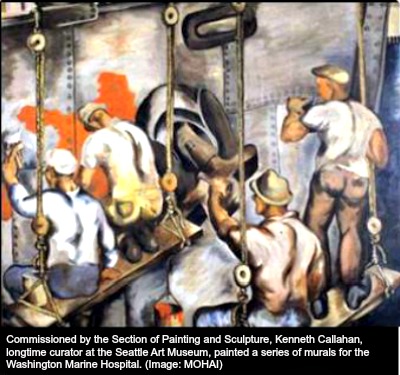Special Section:
Visual Arts in the Great Depression
Over the course of a decade (1933-1943), the New Deal fundamentally reshaped the relationship of the artist to society and of the public to the visual arts. The theory and practice of art, previously reserved for college classrooms and exclusive museums, suddenly and rapidly expanded into every corner of the nation. In Washington State, close to 20 post offices became home to high quality murals, while zoos, high schools and hospitals, among other venues, hosted public displays and exhibitions. Artists at all stages of their careers benefited from the programs, which offered both a steady paycheck at a moment of economic collapse and an unprecedented opportunity for community engagement and feedback.
This special section explores the New Deal art programs that operated in Washington State and profiles some of the artists whose work can often still be found in post offices, schools, and other public buildings. Beginning with the Public Works of Art Project, launched in December 1933 as part of the Civil Works Administration (CWA), the government would invest in the arts as never before, eventually employing well over 5,000 men and women to create and teach in creative fields such as painting, weaving and sculpture. As a result of these programs, which also included the Treasury Section of Painting and Sculpture (the Section), the Federal Art Project (FAP) and the Treasury Relief Art Project (TRAP), thousands of murals, easel paintings, sculptures and fine handicrafts were created, leaving a legacy that is still visible today. Here are the post office murals that can be seen in Washington state.
In Washington State, which had only recently begun to flourish as a center of the visual arts with the establishment of the Cornish School, the creation of a Department of Painting and Design at the University of Washington, the founding of the Henry Gallery and the opening of the Seattle Art Museum, the Depression might well have spelled disaster. Instead, as a result of the federal investments and diverse opportunities offered by the various New Deal initiatives, some of the region's best known artists, including Kenneth Callahan, Fay Chong, Mark Tobey, Morris Graves, Ernest Norling, and Ambrose Patterson, as well as dozens of other gifted individuals, were able to grow and develop their talents, while remaining gainfully employed in creative pursuits.
In addition, the various New Deal programs also offered the public unprecedented access to the visual arts, both because of the location of much of the work (free public buildings) and the themes and style - predominately figurative scenes of local life, history and folklore. While at times overly heroic and celebratory, the art was undeniably democratic in nature, telling stories and representing landscapes that had been absent in the renderings of previous generations.
Eleanor Mahoney is the coordinator of this special section on Visual Arts.
Tour the Visual Arts special section:
 |
Federal Art Project in Washington State
The most ambitious of the New Deal visual arts programs, the Federal Art Project emphasized work relief for artists as well as public education and documentation of folk traditions. In Washington State, it employed dozens of men and women in diverse pursuits such as easel painting, mural painting, sculpture, teaching, model making and more.
|
 |
Public Works of Art Project in Washington State
The first visual arts program launched during the Great Depression, the Public Works of Art Project employed more than 3,000 artists nationwide including 50 in Washington State. It established an important precedent regarding federal government support for the arts and served as a model for later initiatives.
|
 |
Post Office Murals and Art for Federal Buildings: The Treasury Section of Painting and Sculpture in Washington State
Centrally managed by the Treasury Department in Washington, D.C. the Section commissioned thousands of murals, wood carvings and sculptures for public buildings, including post offices, court houses and federal agency headquarters in the capital. As a result of its presence in small and large communities, this program's work is perhaps the best known of any New Deal visual arts initiative.
|
 |
New Deal Post Office Murals in Washington State
This google interactive map marks the location of the 18 Washington State post offices that housed art commissioned by the Section. Common motifs include agriculture, logging and western history, featuring images of both Euro-American settlers and Native peoples. For more information on the Treasury program, please see the research report "The Section of Painting and Sculpture in Washington State,"
|
 |
The Spokane Art Center: Bringing Art to the People
In addition to providing gainful employment to thousands of unemployed artists, the Federal Art Project (FAP) also stressed art education through community art centers as one of its primary objectives. One of the most successful sites, hosting lthousands of visitors and hundreds of classes, was located in Spokane, Washington.
|






